Wildflowers of the Adirondacks:
Whorled Wood Aster (Oclemena acuminata)
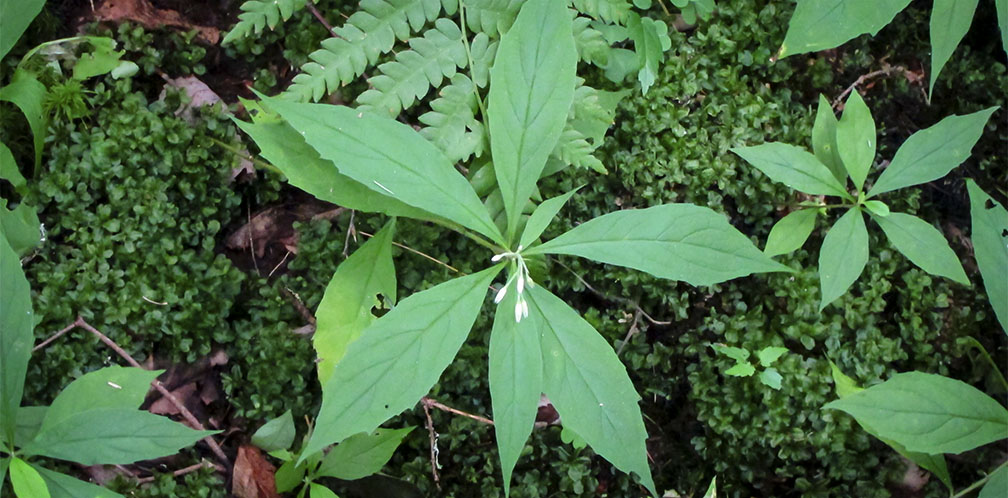
Whorled Wood Aster (Oclemena acuminata) is a native Adirondack wildflower that produces white flower heads with a pink or yellow central disk in late summer. The leaves are large, coarsely toothed, and scattered up the stem in such a way as to appear whorled.
This wildflower is a member of the Aster family (Asteraceae). Whorled Wood Aster is part of the Oclemena genus, which also includes the Bog Aster (Oclemena nemoralis), another aster that occurs in the Adirondacks. Bog Aster is found in acidic bogs.
- This plant was formerly known as Aster acuminatus; and most older sources carry it under this scientific name.
- Other common names for Whorled Wood Aster include Sharp-leaved Aster, Sharp-toothed Nodding-aster, Mountain Aster, Whorled Aster, and Acuminate Aster. The name "aster" is derived from the Latin word for "star."
Identification of Whorled Wood Aster
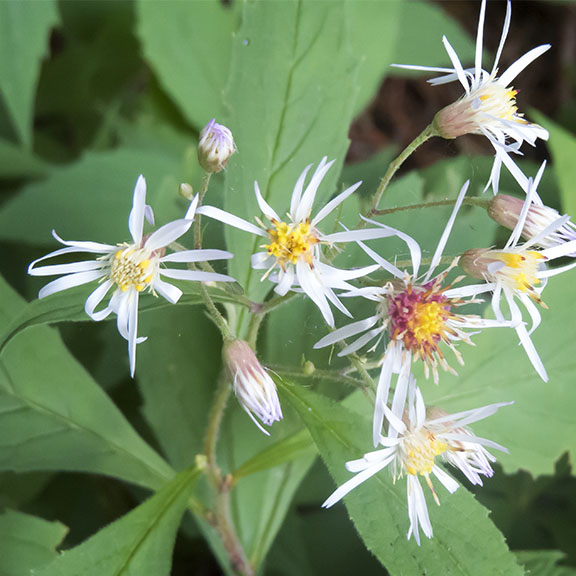
Whorled Wood Aster is an upright plant with slightly zigzag stems. The stems are somewhat hairy.
Most sources indicate that this plant grows from eight inches to 30 or 36 inches high. However, many plants encountered in the Adirondacks (especially in poorer soils) are on the shorter end of this continuum.
Whorled Wood Asters have alternate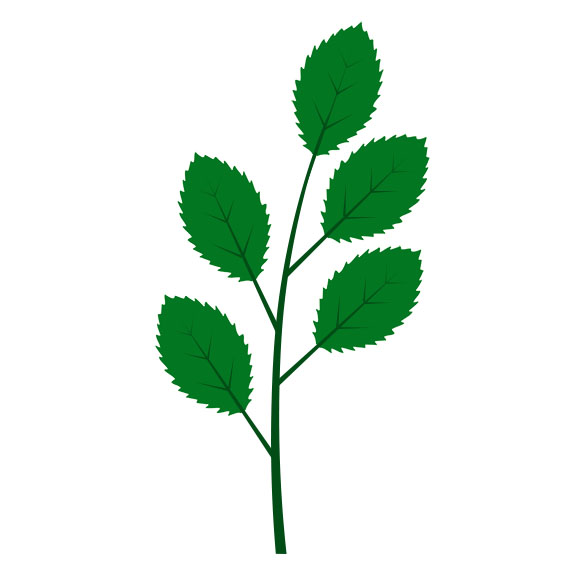 Alternate: An arrangement of leaves (or buds) on a stem (or twig) in which the leaves emerge from the stem one at a time. This often makes the leaves appear to alternate on the stem. leaves, meaning that there is one leaf per node.
Alternate: An arrangement of leaves (or buds) on a stem (or twig) in which the leaves emerge from the stem one at a time. This often makes the leaves appear to alternate on the stem. leaves, meaning that there is one leaf per node.
- The leaves on the upper part of the stem are larger than those on the lower part and are clustered so closely together that they appear to be
whorled
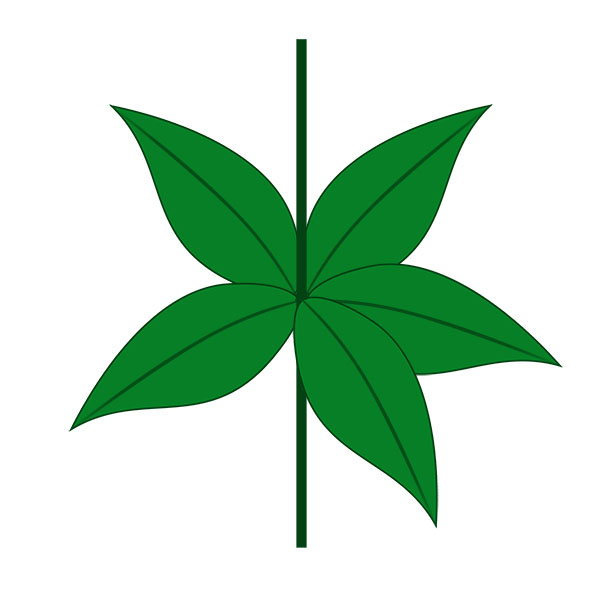 Whorled: Arranged in a circle around a central point.
.
Whorled: Arranged in a circle around a central point.
. - The leaves are
lance-shaped
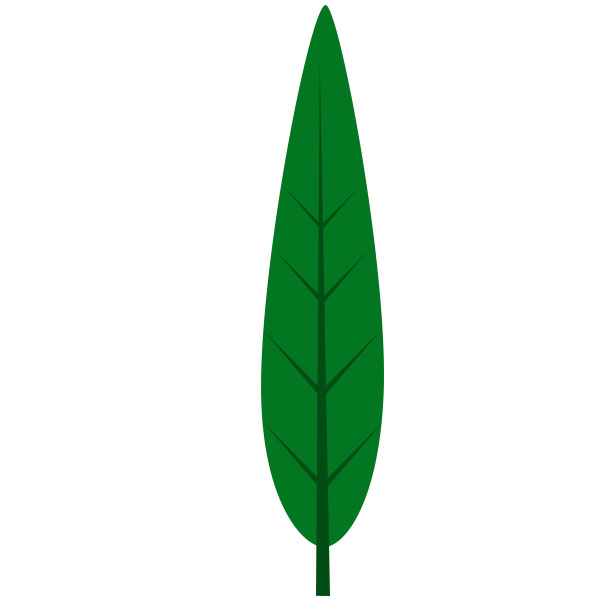 Lanceolate: A leaf shaped like a lance head, tapering to a point at each end. or
elliptic
Lanceolate: A leaf shaped like a lance head, tapering to a point at each end. or
elliptic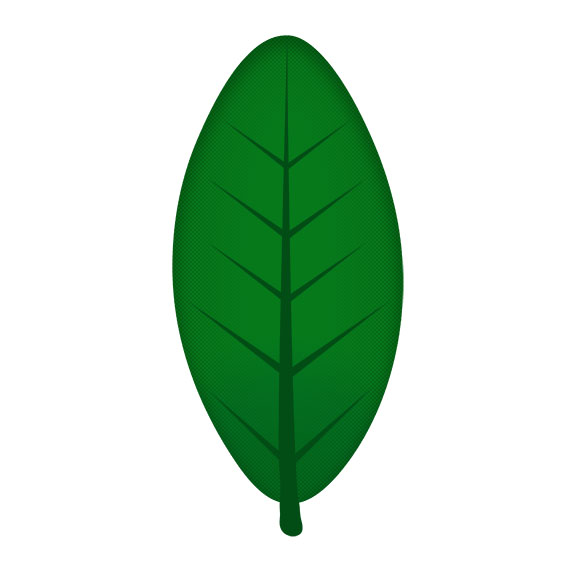 Elliptic: A leaf shaped like an ellipse, widest at the center and tapering at each end. and pointed at both ends.
Elliptic: A leaf shaped like an ellipse, widest at the center and tapering at each end. and pointed at both ends. - The leaf edges are coarsely toothed
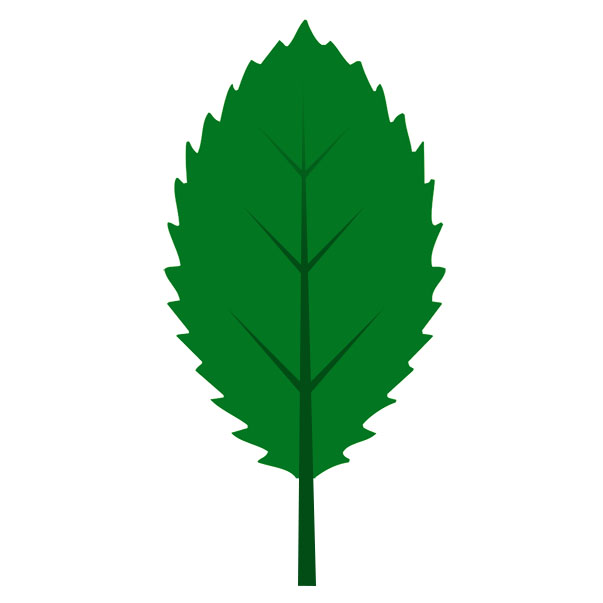 Toothed leaves have a saw-toothed edge.
Toothed leaves have a saw-toothed edge. - There is one main vein
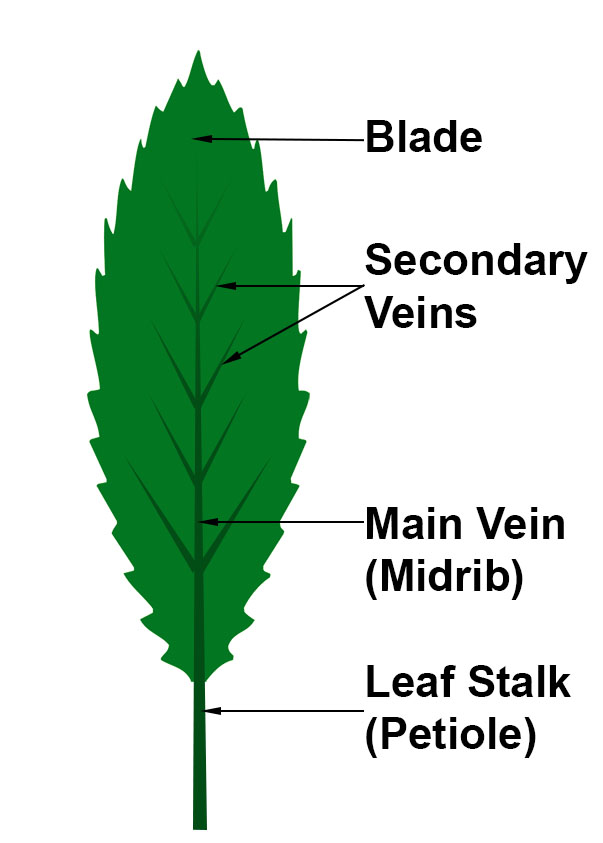 Vein: A vessel that conducts nutrients, sugars, and other substances throughout plant tissues; usually associated with leaves. The arrangement of veins in a leaf is called the venation pattern. running from the base of the leaf towards the tip.
Vein: A vessel that conducts nutrients, sugars, and other substances throughout plant tissues; usually associated with leaves. The arrangement of veins in a leaf is called the venation pattern. running from the base of the leaf towards the tip.
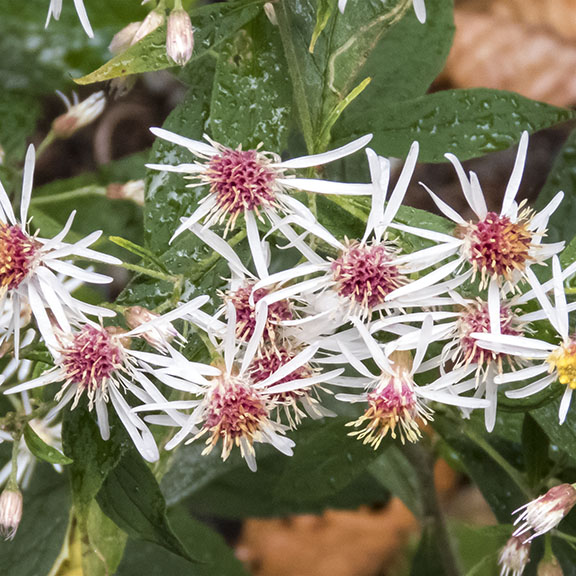
Like other members of the Aster family, Whorled Wood Asters have composite flowers in the form of flower heads made up of much smaller individual flowers which, when viewed from a distance, appear to be a single flower. The individual flowers of the Whorled Wood Aster are of two kinds: disk flowers and ray flowers. Together they form a flower head from 1 to 1½ inches wide.
- The disk (in the center of the flower head) is usually yellow to reddish, appearing somewhat shaggy.
- The disk is surrounded by 12 to 18 petal-like white or (rarely) purplish rays. In contrast to many asters, the ray flowers are not straight, but bent backwards, creating a rather disheveled-looking appearance.
Whorled Wood Asters are among the relatively few woodland wildflowers that bloom in late summer and early fall. In the Adirondacks, this plant generally starts to show buds in late July, blooming through August and September. A tally for the upland Adirondack areas compiled by Michael Kudish, based on data collected from the early seventies to the early nineties, lists the plant as in flower through 3 October.
Uses of Whorled Wood Aster
No edible or medicinal uses for this plant were found.
Wildlife Value of Whorled Wood Aster
Like other asters, Whorled Wood Asters, despite their abundance in many places, are of relatively little importance as a food source for wildlife. Some insects feed on the plant. A few bird species (such as Ruffed Grouse) may consume the seeds; and several mammals (such as Eastern Chipmunks and White-footed Mice) may browse on the plants, but asters represent a very small portion of their diets.
Distribution of Whorled Wood Aster
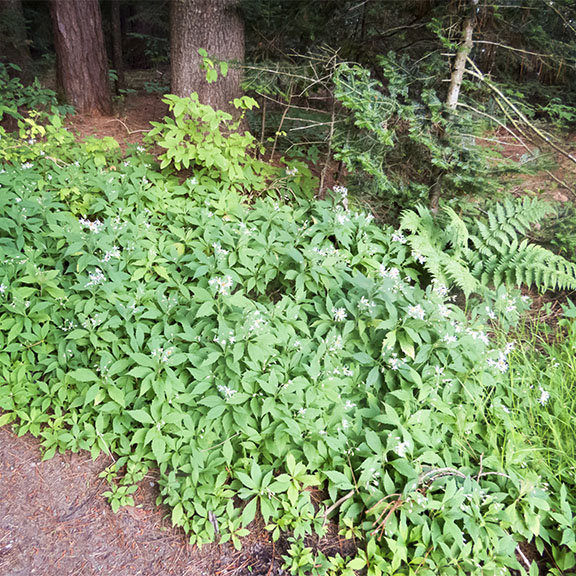
Whorled Wood Asters occur in the eastern third of the United State, including the eastern seaboard states south to Georgia. In Canada, this plant can be found in the eastern provinces, including Newfoundland, Quebec, and eastern Ontario. Whorled Wood Aster is listed as Threatened in Kentucky and Presumed Extirpated in Ohio.
In New York State, this wildflower is found in most counties in the eastern half of the state. It has been documented in all counties inside the Adirondack Park Blue Line except Fulton and Clinton counties.
Habitat of Whorled Wood Aster
Whorled Wood Aster is relatively shade-tolerant and appears to favor well-drained soils, although it will tolerate wetter soils. It can be found in a variety of habitats, including both deciduous and mixed woods forests. Its wetland indicator code is FACU, meaning that it usually occurs in non-wetlands, but can occasionally be found in wetlands.
In the Adirondack Mountains, Whorled Wood Asters are said to be the most common aster of the spruce-fir forest, growing to the timberline. Within the Adirondack Park, these plants are found in a variety of ecological communities:
Whorled Wood Aster is found on many of the trails covered here. Look for it blooming in late summer and early autumn along the Heart Lake Trail, the Peninsula Nature Trails, and some of the wooded trails at Heaven Hill. It can also be found at the Paul Smith's College VIC on the Boreal Life Trail and the Barnum Brook Trail.
References
Michael Kudish. Adirondack Upland Flora: An Ecological Perspective (The Chauncy Press, 1992), p. 198.
New York Flora Association. New York Flora Atlas. Whorled Wood Aster. Oclemena acuminata (Michx.) Greene. Retrieved 11 February 2018.
Integrated Taxonomic Information System. Oclemena acuminata (Michx.) Greene. Retrieved 12 February 2018.
United States Department of Agriculture. The Plants Database. Whorled Wood Aster. Oclemena acuminata (Michx.) Greene. Retrieved 12 February 2018.
Flora of North America. Oclemena acuminata (Michaux) Greene. Retrieved 12 February 2018.
NatureServe Explorer. Online Encyclopedia of Life. Whorled Aster. Oclemena acuminata - (Michx.) Greene. Retrieved 12 February 2018.
Margaret B. Gargiullo. A Guide to Native Plants of the New York City Region (New York City Department of Parks & Recreation, 2007), p. 71.
New England Wildflower Society. Go Botany. Sharp-toothed Nodding-aster. Oclemena acuminata (Michx.) Nesom. Retrieved 12 February 2018.
New York State. Department of Environmental Conservation. New York Natural Heritage Program. Ecological Communities of New York State. Second Edition (March 2014), pp. 109-110, 119-120, 123-124, 124. Retrieved 17 October 2015.
New York Natural Heritage Program. 2015. Online Conservation Guide for Beech-Maple Mesic Forest. Retrieved 22 February 2017.
New York Natural Heritage Program. 2015. Online Conservation Guide for Ice Cave Talus Community. Retrieved 14 March 2017.
New York Natural Heritage Program. 2015. Online Conservation Guide for Mountain Fir Forest. Retrieved 22 February 2017.
New York Natural Heritage Program. 2015. Online Conservation Guide For Mountain Spruce-Fir Forest. Retrieved 22 February 2017.
New York Natural Heritage Program. 2015. Online Conservation Guide for Spruce-Fir Rocky Summit. Retrieved 6 March 2017.
New York State. Adirondack Park Agency. Preliminary List of Species Native Within the Adirondack Park Listed Alphabetically by Scientific Name and Sorted by Habit. Volume 1. Updated 10.23.2006, p. 29. Retrieved 26 January 2017.
Connecticut Botanical Society. Whorled Wood Aster. Oclemena acuminata (Michx.) Nesom. Retrieved 12 February 2018.
Illinois Wildflowers. Plant-Feeding Insect Database. Oclemena acuminata. Whorled Wood Aster. Retrieved 12 February 2018.
Lady Bird Johnson Wildflower Center. Oclemena acuminata. Retrieved 12 February 2018.
iNaturalist. Adirondack All-Taxa Biodiversity Inventory. Whorled Wood Aster. Oclemena acuminata. Retrieved 12 February 2018.
Roger Tory Peterson and Margaret McKenny. A Field Guide to Wildflowers. Northeastern and North-central North America (Houghton Mifflin Company, 1968), pp. 94-95.
Doug Ladd. North Woods Wildflowers (Falcon Publishing, 2001), p. 164.
Lawrence Newcomb. Newcomb's Wildflower Guide (Little Brown and Company, 1977), pp. 456-457.
David M. Brandenburg. Field Guide to Wildflowers of North America (Sterling Publishing Company, Inc., 2010), p. 145.
William Carey Grimm. The Illustrated Book of Wildflowers and Shrubs (Stackpole Books, 1993), pp. 294-295.
Mark J. Twery, et al. Changes in Abundance of Vascular Plants under Varying Silvicultural Systems at the Forest Ecosystem Research and Demonstration Area, Paul Smiths, New York. USDA Forest Service. Research Note NRS-169. Retrieved 22 January 2017, p. 7.
Alexander C. Martin, Herbert S. Zim, and Arnold L. Nelson. American Wildlife & Plants. A Guide to Wildlife Food Habits (Dover Publications, 1951), p. 419.
John Eastman. The Book of Forest and Thicket: Trees, Shrubs, and Wildflowers of Eastern North America (Stackpole Books, 1992), pp. 9-10.
Iowa State University. BugGuide. Acrocercops astericola. Retrieved 12 February 2018.
Nancy G. Slack and Allison W. Bell. Adirondack Alpine Summits: An Ecological Field Guide (Adirondack Mountain Club, Inc., 2006), p. 28.
Allen J. Coombes. Dictionary of Plant Names (Timber Press, 1994), p. 19.
Charles H. Peck. Plants of North Elba. (Bulletin of the New York State Museum, Volume 6, Number 28, June 1899), p. 106. Retrieved 22 February 2017.
